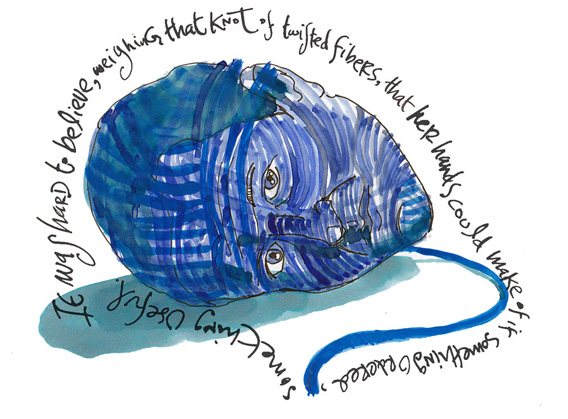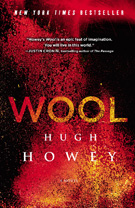
Slate is an Amazon affiliate and may receive a commission from purchases you make through our links.
Wool, Gathering
How self-pubbed best-seller Hugh Howey overturned the author-reader relationship—and wrote the next great sci-fi saga.

Illustration by Danny Gregory
You can also listen to this article.
When bookstore employee and indie author Hugh Howey published his short story “Wool” as a 99-cent e-book on Amazon in July of 2011, he wasn’t banking on the story transforming his career. He didn’t even post a link to the story on his own website. But “Wool,” about a post-apocalyptic future in which society has been forced to live underground in a vast silo, quickly became the most popular thing he had ever written. By the end of October, the story had made it on the Kindle sci-fi best-seller list. Howey started to get emails from readers asking him for the rest of the story. There was no rest of the story, so Howey decided to write it.
By January 2012, Howey had self-published five serial stories about that underground silo and collected all five into an ebook, the Wool Omnibus. Even as the Omnibus landed on the New York Times best-seller list in the summer of 2012 , Howey kept churning out prequels. And by the end of 2012, Howey had negotiated sweetheart deals with major publishing houses to release print editions of Wool worldwide and had even optioned the film rights to Ridley Scott. Simon and Schuster releases Wool, a print edition of the Wool Omnibus, this month.
Howey’s self-publishing Cinderella story is so compelling that it often becomes the media story about Wool. But way more fascinating than that is the way the world of Wool reflects our own world—and how Howey’s interactions with readers are overturning the traditional relationship between an author, his creations, and his audience.
As Wool opens, Holston, the sheriff of the silo, is being sent to “cleaning,” a punishment that takes him to the toxic surface to scrub the sensors that project a view of the world above to the silo below. The description of the view is one of the only clues Howey provides about the world before the silo was created. It’s a “familiar and rotting skyline” in which “ancient glass and steel stood distantly where people, it was suspected, had once lived aboveground.” Like his wife, who had been sent to cleaning three years prior, Holston had committed the worst sin imaginable in the silo: asking to go outside. In Wool, cleaning is both death sentence and human sacrifice: The pressure felt by thousands of people underground grows “like steam building up in the silo, ready to launch something out” and is transferred to one person, purged in an act conceived to remind the community that their silo is a shelter, not a prison.
Of course, the silo feels like both, and that tension is at the heart of Wool. Holston’s cleaning sets off a chain of events that transition the action from short story to serial novel. Soon, the mayor of the silo needs to appoint a new sheriff and selects a smart and strong-willed candidate from the silo’s mechanical department named Juliette. Juliette becomes obsessed with figuring out Holston’s motivations, and her subsequent determination to uncover the truth about the silo’s history and who’s really in control of it (which I won’t reveal here) creates the powder keg for an uprising within the silo. The escalation of anger to fissures within the silo and then finally to conflict is rendered deftly, and the pace at which Howey reveals the inner workings of the world of the silo makes Wool a page-turner.

The intrigue of Wool (the title comes from the scrubbers used by people sent to clean the sensors on the surface) is enjoyable and thought-provoking, but it’s how Howey borrows from our present that really makes Wool resonate with readers. In many ways, the silo is a triumph of human survival and sustainability. It’s an energy-independent community with 100 percent employment and universal access to education and health care. But it’s also a carefully designed system with zero population growth, a lack of media, and social stratification created by the architecture of the silo itself. More than 100 floors deep and connected by only a narrow circular staircase, the silo is designed to limit mobility and communication, separating the mechanical department at the bottom, the mayor and sheriff up top, and the IT department as far away from both of them as possible. Readers’ fascination of Wool is powered not by the novelty of the silo, but the frightening familiarity of it. While most post-apocalyptic fiction invites us to imagine how civilization might evolve after the world as we know it ends, Wool instead invites us to imagine what it might take—and what the costs might be—to prevent civilization from ever evolving beyond where we are right now.
Howey also taps into many of our current anxieties. Who controls the flow of information to all of our screens? How much privacy and control are we willing to give up to ensure domestic security? And how much good will it do to know the truth if you can’t change the system? It’s this last question that fuels uprising in the silo. Knox, the head of Mechanical who rallies his colleagues and others to revolt, explains why his anger compels him to violence: “I only want to hurt those that lied,” he says. “That’s all any of us want. We’ve all lived in fear. Fear of the outside. Fear of cleaning. Afraid to even talk about a better world. And none of it was true. The system was rigged, and in a way to make us hang our heads and take it.” Being in the silo is like living in a world where the decisions were made a long time ago by people you didn’t vote for. Sound familiar?
The disenfranchisement of silo residents contrasts interestingly with the way the stories themselves invert the traditional power dynamic between author and fan. By reaching out to Howey and leaving reviews that asked for more, fans helped conjure the fictional world that has come to mean so much to them. And through the power of self-publishing and social media, Howey converted interest in the first story into dedicated fandom and hundreds of thousands of e-book sales. By publishing Wool serially, he was able to deliver stories quickly, building readership, excitement, and Amazon reviews that often resulted in Wool stories occupying multiple slots on the same Amazon best-seller lists. He has extensively blogged about his progress, posted videos on his website, and responded personally to his readers via email, social media, and meetups. He hid his phone number on the cover of one of his self-published print editions as an Easter egg to fans, and he’s taken the time to have phone conversations with fans that have called him. He’s even sprinkled a few references to specific fans in his more recent stories, including a mention of the navy ship USS The Sullivans, whose crew—living themselves in something of a “silo at sea”—wrote to him about how much they loved Wool.

Courtesy of Simon & Schuster
Most intriguingly, Howey has encouraged readers who want to develop their own Wool stories to self-publish and sell their works. In an interview, I asked Howey about why he’s not just encouraging fan fiction but actually endorsing it. “There’s room for readers to become writers and play in this world,” he said. “I view fan fiction as the opportunity to teach readers how much joy there is in creating worlds instead of just living in them.” Right now—much to Simon and Schuster’s chagrin, one has to imagine—the first two of what are sure to be many Wool-related fan fiction stories are available for sale on Amazon.
But Howey is making some changes with Dust, the Wool sequel he’s currently writing. First, it likely won’t be a serial. “I think I’m going to write it as a single work,” said Howey. “In fairness to the reader, I think it’s going to be nice to give them the entire work so they don’t have to wait in between pieces.” The sequel also promises to be darker than Wool: “At what point does an uprising cause more harm than an evil totalitarian regime?” asked Howey. “That’s not a fun question to ask, because we’re used to telling stories where we overthrow the bad guys and everyone lives happily ever after.”
Will fans tolerate a Juliette who does as much harm as good? Will fans tolerate a Howey who does not solicit feedback and encouragement as he creates the next (and final, he says) installment of their favorite series? Perhaps not, and it’s fascinating that Howey’s planning on exercising his authorial power without necessarily seeking buy-in from readers. It’s a little bit more silo-like than what he’s done in the past.
“That’s a challenge,” Howey noted. But he promised an apology to readers at the end, and an opportunity that will continue his stories’ reimagining of the author/reader relationship: “Like, ‘Thank you for suffering through all of this; here’s a glimmer of hope. Now go write some fan fiction and tell me what happens next.’ ”
---
Wool by Hugh Howey. Simon and Schuster.
See all the pieces in this month’s Slate Book Review.
Sign up for the Slate Book Review monthly newsletter.